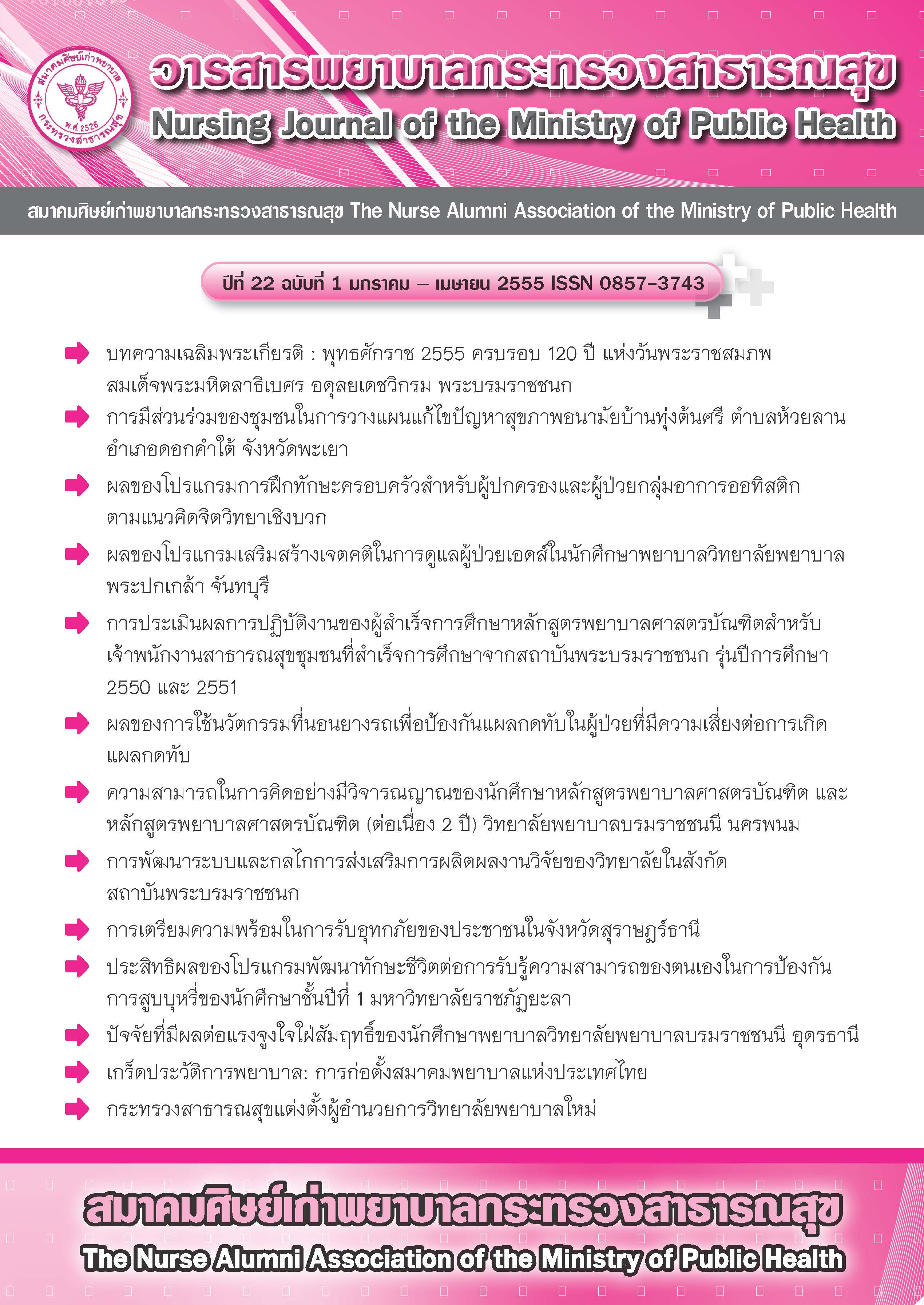การเตรียมความพร้อมในการรับอุทกภัยของประชาชนในจังหวัดสุราษฎร์ธานี
Main Article Content
บทคัดย่อ
บทคัดย่อ
ปัจจุบันภัยพิบัติทางธรรมชาติได้เกิดขึ้นบ่อยครั้ง ในจังหวัดสุราษฎร์ธานีก็ได้เกิดอุทกภัยขึ้นในรอบปีที่ผ่านมา การวิจัยครั้งนี้เป็นการวิจัยเชิงสำรวจเพื่อศึกษาการเตรียมความพร้อมในการรับอุทกภัยและปัจจัยที่มีผลต่อการเตรียมความพร้อมในการรับอุทกภัยของประชาชนใน จ.สุราษฎร์ธานี โดยประชากรเป็นประชาชนในจังหวัดสุราษฏร์ธานี ที่ได้รับผลกระทบจากอุทกภัยที่อาศัยอยู่ในอำเภอท่าชนะ อำเภอไชยา และอำเภอวิภาวดี รวม 107,248 คน คำนวณขนาดกลุ่มตัวอย่าง ได้จำนวน 400 คน สุ่มตัวอย่างแบบแบ่งกลุ่ม เครื่องมือที่ใช้ในการเก็บข้อมูลเชิงปริมาณเป็นแบบทดสอบความรู้เกี่ยวกับอุทกภัย แบบสอบถามแบบมาตราส่วนประมาณค่าในประเด็น การได้รับข่าวสาร การตระหนักถึงปัญหาและการเตรียมความพร้อมรับอุทกภัย ส่วนข้อมูลเชิงคุณภาพเป็นแบบสัมภาษณ์เชิงลึกโดยผ่านการตรวจสอบความเที่ยงตรงของผู้ทรงคุณวุฒิ 3 คน ได้ค่าดัชนีความสอดคล้องอยู่ระหว่าง 0.6-1.0 และทดลองใช้ได้ค่าความเชื่อมั่นอยู่ในช่วง 0.81-0.91 วิเคราะห์ข้อมูลโดยใช้สถิติเชิงพรรณนา และการวิเคราะห์ถดถอยพหุคูณ เพื่อทดสอบปัจจัยที่มีผลต่อการเตรียมความพร้อมในการรับอุทกภัย วิเคราะห์ข้อมูลเชิงคุณภาพโดยใช้วิธีการวิเคราะห์เนื้อหา (Content Analysis)
ผลการวิจัยพบว่าประชาชนในจังหวัดสุราษฎร์ธานีมีความรู้เกี่ยวกับอุทกภัยอยู่ในระดับมาก (x̄=3.96)โดยมีความรู้เกี่ยวกับผลกระทบด้านสุขภาพมากที่สุด ได้รับข่าวสารอยู่ในระดับมาก (x̄=3.89) โดยการติดตามข่าวพยากรณ์อากาศผ่านโทรทัศน์ และวิทยุ ความตระหนักถึงปัญหาอุทกภัยอยู่ในระดับปานกลาง (x̄=3.58) โดยให้ความสำคัญต่อเรื่องโรคติดต่อ และความเป็นอยู่ลำบาก การเตรียมความพร้อมอยู่ในระดับปานกลาง (x̄= 3.33) โดยมีการเตรียมความพร้อมในเรื่องอาหารสำเร็จรูป ของใช้ส่วนตัว อุปกรณ์ส่องสว่าง (x̄=4.32–4.56) แต่มีการเตรียมความพร้อมด้านหาความรู้เกี่ยวกับอุทกภัย การเตรียมที่อยู่อาศัย และการสื่อสาร-สัญจร ค่อนข้างน้อย (x̄=2.22–3.07) ปัจจัยที่มีผลต่อการเตรียมความพร้อมรับอุทกภัย มี 2 ปัจจัยได้แก่ ความตระหนักในปัญหาอุทกภัย และการได้รับข้อมูลข่าวสารเกี่ยวกับอุทกภัย โดยตัวแปรทั้ง 2 ปัจจัย สามารถอธิบายการเตรียมความพร้อมในการรับอุบัติภัยได้ร้อยละ 43.8 (R2=43.8, P<.01)
จากการสัมภาษณ์เชิงลึกพบว่า ประชาชนส่วนใหญ่เตรียมข้าวของเครื่องใช้จำพวกอาหารแห้ง เช่น ข้าวสาร ปลากระป๋อง มีการปรับปรุงบ้านเรือนโดยการยกพื้นบ้านให้สูง ยังไม่มีการรวมตัวของคนในชุมชนแม้จะตระหนักว่าการป้องกันความเสียหายจากน้ำท่วมเป็นหน้าที่ของทุกคน ความเสียหายจากอุทกภัยครั้งที่ผ่านมาเนื่องจากไม่คาดว่าน้ำจะท่วมมาก เพราะเป็นน้ำหลากนอกฤดูกาล แต่คิดว่าปัญหาน้ำท่วมจะมากขึ้นเนื่องจากมีการสร้างถนนขวางทางน้ำไหล การตัดไม้ทำให้น้ำหลากมาเร็วและเป็นขี้โคลน อยากให้มีการวางท่อระบายน้ำให้มากขึ้น และอยากให้มีการเตือนภัยก่อนโดยใช้เสียงตามสาย รถประชาสัมพันธ์ และผู้นำชุมชน
จากผลการวิจัยนี้มีข้อเสนอแนะ คือหน่วยงานที่เกี่ยวข้องควรประชาสัมพันธ์ ให้ข้อมูลและสร้างความตระหนักกับประชาชน ในการเตรียมความพร้อมเพื่อรับอุทกภัย รวมทั้งการให้เสียงตามสาย ย้ำเตือนถึงเหตุการณ์และผลลัพธ์ที่จะเกิดขึ้นหากไม่มีการเตรียมความพร้อม
คำสำคัญ: การเตรียมความพร้อม อุทกภัย
Abstract
Globally, natural disasters are happening more frequently. In Suratthani Province, Thailand flooding occurs twice last year. This descriptive research aimed to identify the preparation for flooding and to study the factors affecting the preparation for flooding by residents in Suratthani Province. Four hundred respondents were randomly selected from Thachana District, Chaiya District, and Wipawadee District to answer a questionnaire and take part in an interview.
The quantitative data were collected using a structured questionnaire. The questions included their general knowledge of flooding. A rating scale asked about the information they received about flooding, their awareness of flooding-related problems, and their preparation against the flooding. The qualitative inquiry comprised in-depth interviews. The questionnaires were validated by experts and had been trialed the in the field. The reliability of the question was 0.81 – 0.91. The quantitative data were analyzed by employing descriptive statistics and Linear Regression Analysis. The qualtitative data was analyzed by content analysis.
The result revealed that the knowledge level about flooding was at a good level; particularly the impact of flooding when it was at a particularly high level. The information the residents received was also reported as good. The level of flooding awareness was rated as fair and the preparation against flooding was also rated as fair. The majority of respondents prepared foods, personal-items for use, and sources of lighting in preparation for the flooding. However, the preparations regarding knowledge about flooding, housing, and communication and traffic were rated at poor levels. Factors significantly affecting the preparation against flooding included the level of awareness of the problem and flooding information (R2 = 43.8).
The result from the in-depth interviews showed that a majority of respondents prepared rice and canned fish and they improved their house protection by lifting up the house’s floor. Even though the respondents were aware of the problems, no group worked together in preparation for the t flooding in their community or prepared for unexpected summer flooding. They thought that the flooding came not only from the changing weather, but also from the newly constructed roads that blocked the water drainage routes. The loss of trees was another factor that the respondents felt contributed to the flooding. The respondents pointed out that the community needed to have a better water drainage system and a flood warning through public announcement, such as a local radio, a public speakers, village leaders, and volunteers. Similarly, that involved organizations should prepare the residents and the community by increasing their knowledge, awareness, and the tools that can be used to cope better with the flooding. The respondents felt this could be achieved through public announcements and disaster volunteers or teams.
Key words: Preparation for flooding, Thailand
Article Details
บทความและรายงานวิจัยในวารสารพยาบาลกระทรวงสาธารณสุข เป็นความคิดเห็นของ ผู้เขียน มิใช่ของคณะผู้จัดทำ และมิใช่ความรับผิดชอบของสมาคมศิษย์เก่าพยาบาลกระทรวงสาธารณสุข ซึ่งสามารถนำไปอ้างอิงได้

